Shelter is your #1 survival priority (even more so than emergency food or water!), so knowing how to make a survival shelter is something everyone should know.
Here we show you how to build a survival shelter with 11 simple designs that could save your life.
Some require a tarp, and some use only debris and wood that has been scavenged.
Don’t forget to practice it so you’ll be prepared should you ever need this survival skill!
Step 1: Choose Your Site
Choose a spot for your wilderness shelter which is:
Dry
Flat
Not right next to a body of water.
Not underneath any cliffs, falling rocks, or dead limbs which could fall on you
Is readily visible or very well hidden (depending on whether you want to be found or not)
Have a good place for a fire right in front of the doorway (see how to start a fire without matches.)
A note about choosing a flat site for your shelter. This is not just for comfort!
If your shelter is on a slope and it starts raining, rainwater can come into your shelter.
If you cannot find a flat spot for building your shelter and rain is likely, you will need to dig trenches to divert the water away from the shelter.
Step 2: Assess Your Needs
Many wilderness survival experts will tell you that this or that method is the best survival shelter. However, it depends on your needs.
Here are some of the things you need to consider:
- How many people are in your group?
- Does your shelter need to be camouflaged?
- How cold is it? Will you build a fire inside or directly in front of your shelter?
- How much time do you have to make the shelter?
- Is the shelter for long-term or short-term use?
Tools
While not essential, it will be a lot easier to make these shelters if you have some basic tools available:
- Some kind of shovel – See Best Survival Shovel
- Survival Knife – See Best Cheap Survival Knife
- Bushcraft Axe
- Folding saw
- Machete – See Best Survival Machete
Step 3: Decide On a Type of Shelter
This is the most essential part of building a shelter in the wilderness. If you know a few shelter designs AND know what they are best suited for, you will be able to make the right choice.
1. The Tarp Shelter
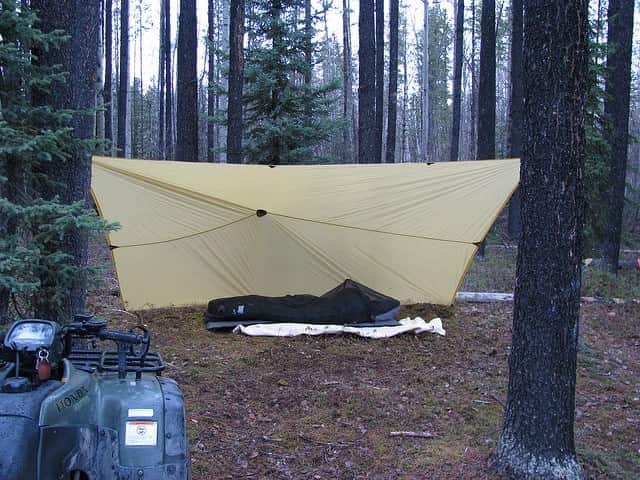
You just need a plastic tarp and some cordage for this survival shelter. You can even make it with a rain poncho in a pinch. Just tie each end of the tarp to a tree.
Pros
Fastest to build
Very easy to build
Good for larger groups
Cons
Poor protection from wind and rain
Could easily break from falling sticks, hard rain, etc.
No protection from animals
2. Tarp Tent
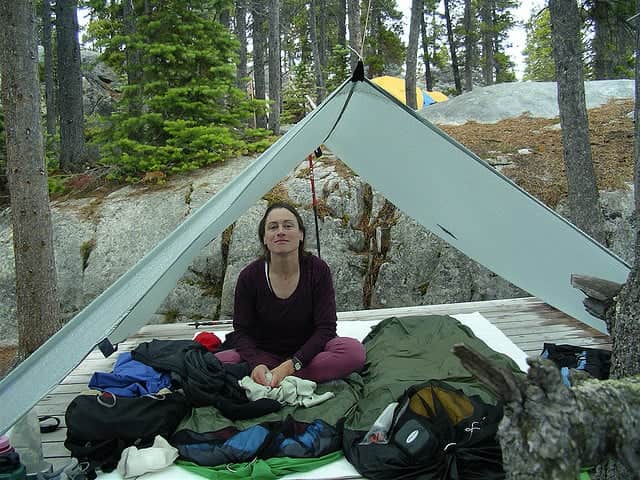
Just tie some cordage between two trees and drape your tarp over it. Then use some rocks, sticks, or more cordage to anchor the sides of the tarp away from you. Read our guide to survival tarps.
Pros
Fast and easy to build
Protects from rain
Cons
Only moderate protection from wind
Could easily break from falling sticks, hard rain, etc.
No protection from animals
3. Tarp Teepee with Poles
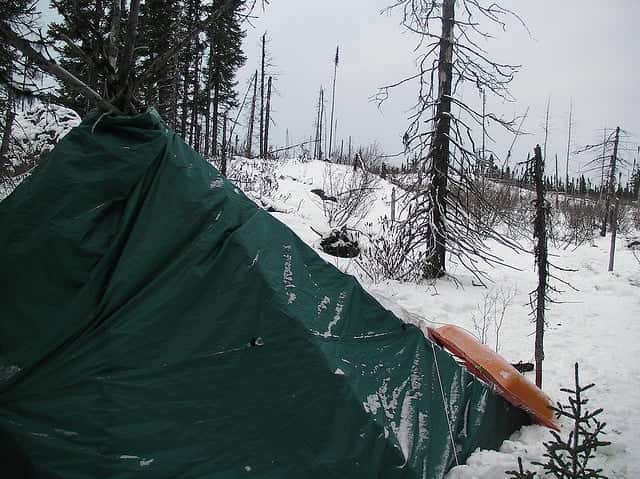
You need to gather some long branches (your poles) and prop them together to form the structure for the teepee (practice this; it is a bit trickier than it may seem to make the structure sturdy!).
Then wrap your tarp around the poles. If it rains, some rain will fall through the hole where the poles meet. You can fix this problem by draping another tarp or poncho over the top. Or, make a bigger hole, and you can even have a fire inside your teepee!
Pros
Suitable for larger groups
Good protection from elements
Sturdy
Possible to have a fire inside teepee; suitable for winter situations
Cons
Requires some practice to build
Need very large tarp
Will be a hole at top of the teepee where rain can enter
4. Tarp Teepee (no poles)
Fold your tarp into a triangular shape. At the point of the triangle, put a rock into the tarp. Then tie some cordage around the stone. Now hang this cordage from a tree. Anchor the bottom of the tarp down with rocks, and you’ve got yourself a teepee.
Pros
Good protection from elements
Tree overhead provides additional shelter
Cons
Need a very large tarp, or else it will be a very small shelter
Can be tricky getting cord tied to tree branch
5. Snow Shelter
What do you do in an emergency outdoors in the snow?
It will be too cold to spend much time making a shelter—this survival shelter you can make very fast (especially if you have an emergency shovel).
Find a tree and prop a branch against its trunk at a 45-degree angle. Push the snow out of the way to form a “wall.” Prop another branch to support your tarp. Then drape a tarp over the branches.
You can line the inside of this survival shelter with pine needles and brush to act as insulation and keep you warm.
For an alternative that takes much more time, see how to build a snow cave.
Pros
Suitable for winter survival situations
Can be made bigger or smaller depending on group size
Cons
Moving snow can be time-consuming and draining without a shovel
Can’t keep a fire burning inside; a teepee might be a better option
6. Fallen Tree Shelter
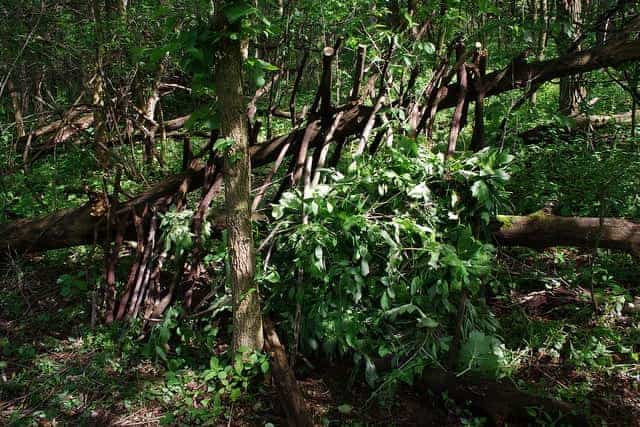
This is my favorite survival shelter because it can be easily adapted to the situation. It does rely on you being able to find a fallen tree, though.
You can do it in multiple ways, such as draping a tarp over a fallen tree to make a tent. Or you can prop debris to act as your shelter wall. If windy or cold, use other debris to block the entrance.
Pros
Easy to camouflage
Good protection from the elements, including snow
Adaptable to multiple situations
Can be made easily with a tarp or with just debris
Cons
Be prepared to share the shelter with bugs from the rotting log!
Will take some time to gather debris to block off entrance
7. Hammock Survival Shelter
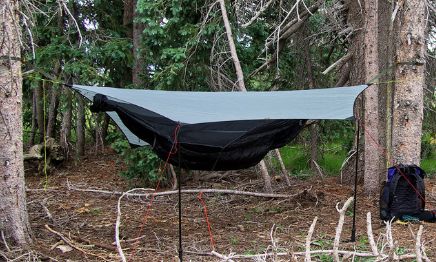
Sometimes you need your survival shelter to be off the ground, such as in jungle situations with creepy-crawly insects and animals around.
This survival shelter design is perfect for that. It is a variation of the tarp tent, just off the ground. Line the survival hammock with your extra clothes to provide some insulation.
Pros
Off the ground
Cons
Need hammock or extra tarp and cordage for hammock
Not much protection from the elements
8. A-Frame Brush Shelter
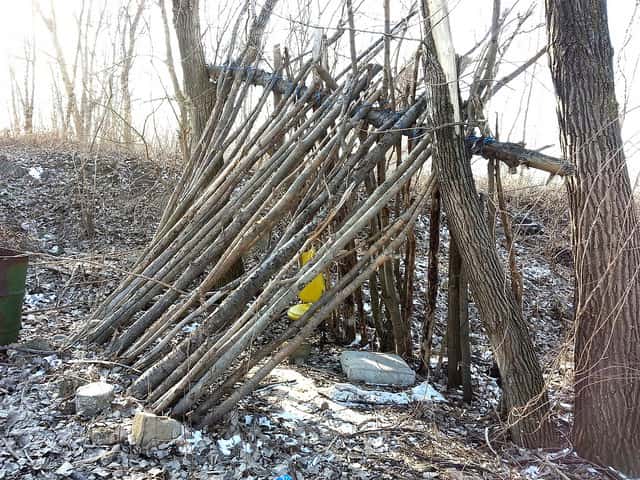
This is an excellent short-term survival shelter for a single person because it is fast and easy to build. It is also easy to find materials for making it.
Pros
One person
Fast to build
Very easy to build
Camouflaged
Cons
Temporary/short-term
Fire won’t warm inside the shelter
How to Build the Shelter:
- Find one long, sturdy branch. It should be a few feet longer than your height.
- Prop one end of branch up on a tree stump or log. Alternatively, you can prop it up on two shorter branches, making an A shape.
- Lean shorter branches against the branch. Now you have a frame.
- Now cover the frame with leaves, branches, or other brush.
*You can also make this survival shelter against fallen trees. Or, prop up both ends of your long branch for a larger A frame shelter. With this method, though, wind can blow in from the sides, and it also won’t trap your body heat as well.
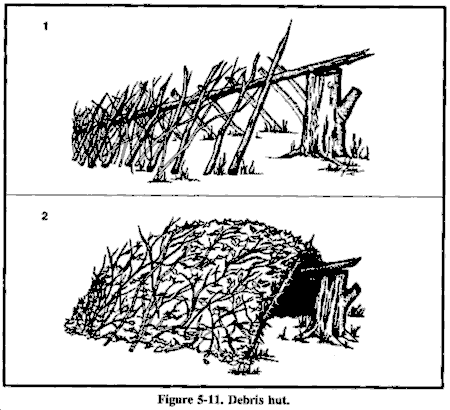
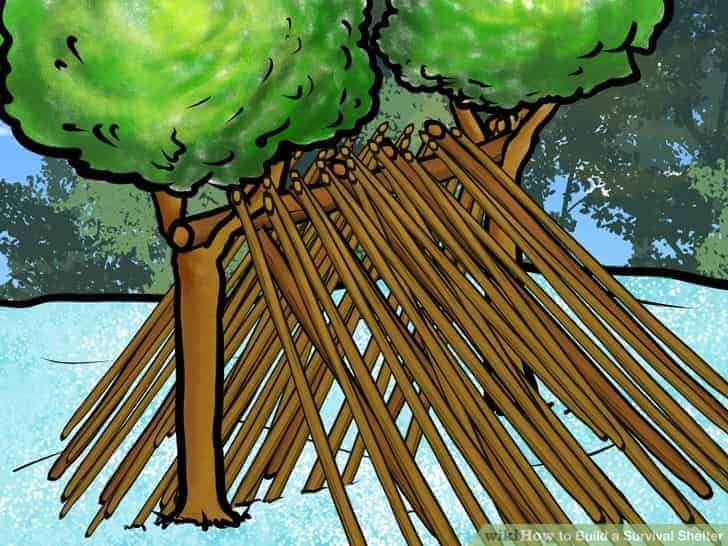
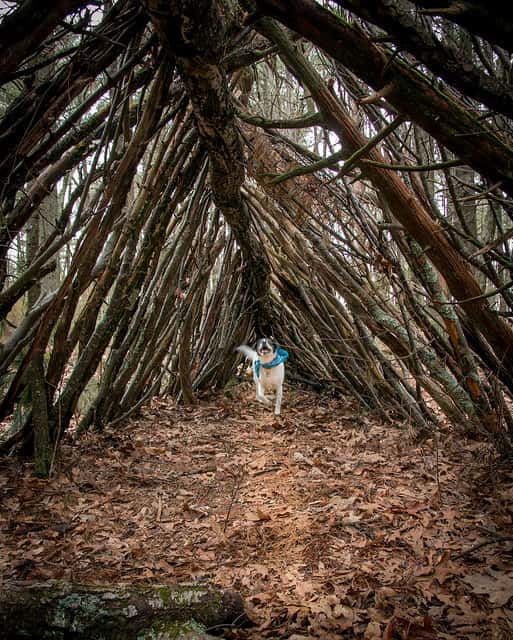
9. Debris Tipi Shelter (Teepee)
You are probably familiar with this shelter design, and maybe you even made a few (I know I made them as a kid). These are relatively easy to build, but you’ll need to have a lot of long branches around.
Another downside of the tipi shelter is that its high, vertical shape makes it relatively unstable during high winds. Because it is large, it won’t trap your body heat as well as a smaller brush shelter would.
Pros
Easy to build
Suitable for larger groups of people
Cons
Requires lots of long branches
Not suitable for high winds
Doesn’t trap body heat as well as some shelter designs
Fire won’t warm inside the shelter
Will need to use leafy branches for covering as leaves and brush tend to blow away
How to Build the Shelter:
- Find three long branches that are relatively the same length. Prop these up to make a tripod frame. This can be somewhat difficult to do without a rope. Alternatively, you can prop the branches against a tree to make a modified tipi shelter.
- Add more long branches to the tripod you built. The more branches you build, the sturdier the frame will be. Remember to leave a gap for the doorway to the shelter.
- Keep adding branches, including shorter ones. There should be as few cracks as possible in the frame.
- Cover the frame with leafy branches. Brush doesn’t work very well for covering because it quickly blows away. Birch bark also works great for a covering – don’t peel all the bark away unless you are in an actual survival situation as it will kill the tree!
- If you do use brush for covering the tipi shelter, you’ll need to add more branches to the outside to prevent them from blowing away.
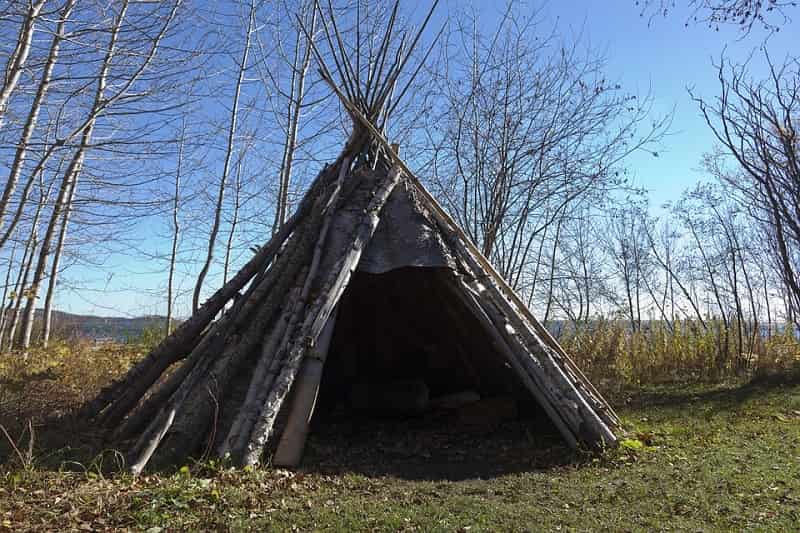
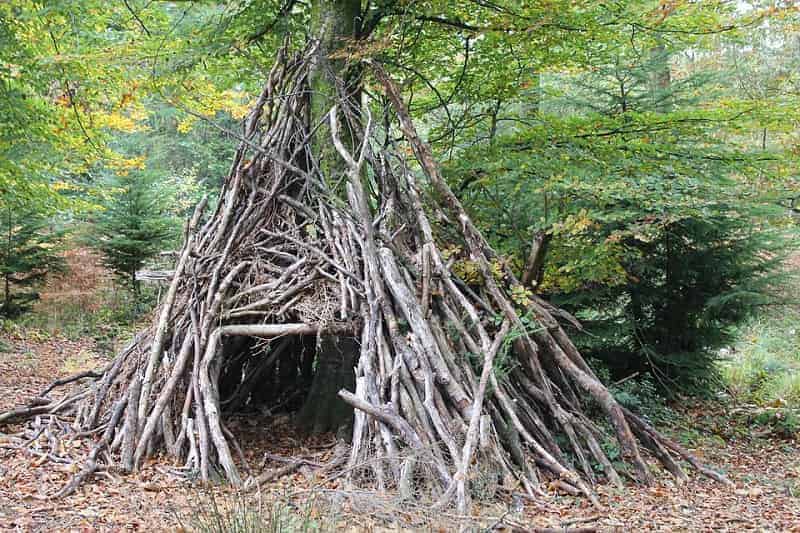
10. Debris Lean-To
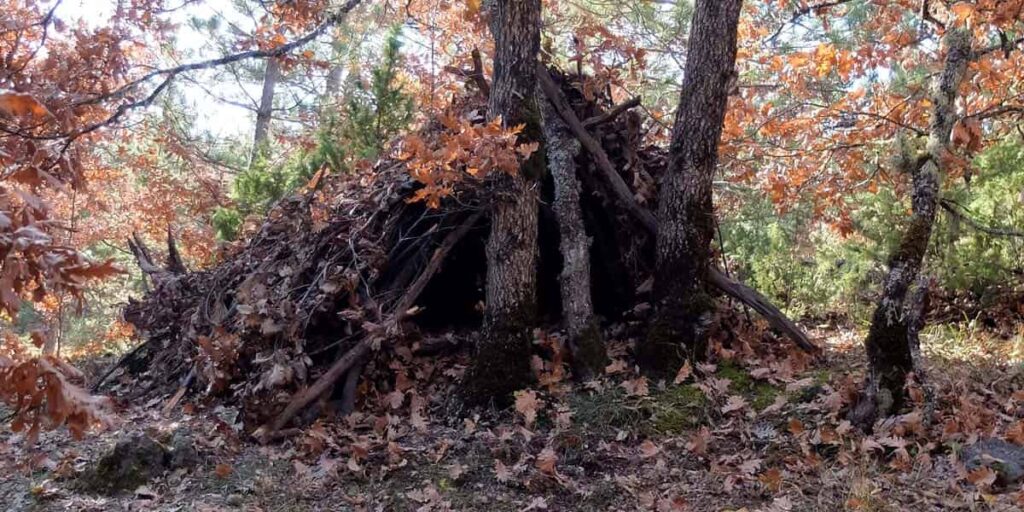
The lean-to shelter is easy to make and roomy. It doesn’t trap body heat, as well as a completely enclosed shelter. However, the wall of the shelter also acts as a fire reflector.
If you make a fire in front of the shelter, the heat will bounce off the wall and keep you warm. To make it even better for cold weather, make a fire reflector/wind screen on the other side of your fire pit.
Pros
Easy and fast to make
With the addition of a “raised survival bed” and wind screen, it can be suitable as a long-term shelter
Cons
Not very warm by itself; will need to make a fire and preferably also a windscreen/fire reflector
Wind can get in from the sides
Not very camouflaged
For a practical demonstration, check this post where we went out into the woods to build a lean to shelter from scratch.
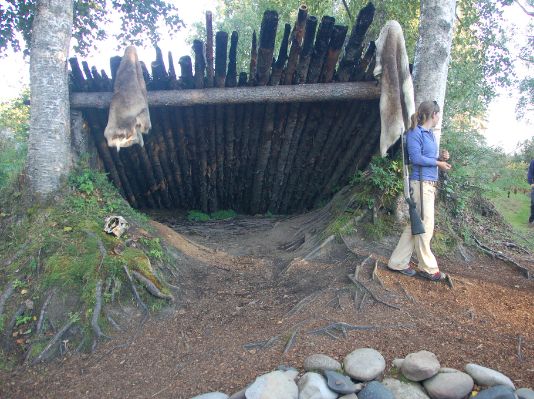
11. Brush Shelter with a Smoke Hole
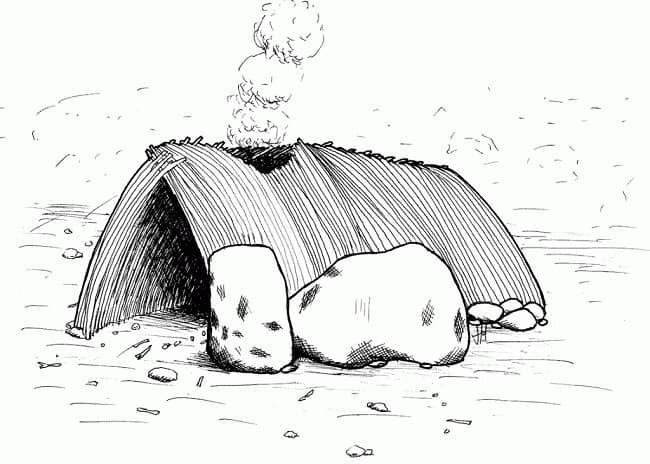
There are a bunch of ways to make shelters with smoke holes. You could make a tipi-style shelter and leave a hole in the top. Or you could dig an earthen pit house shelter with a hole for a fire inside.
Unless it is truly freezing cold, never make a fire inside your shelter! The risk of burning your shelter — and yourself — is too significant. If you do need to make a fire, it will need to be VERY SMALL and controlled.
Pros
Many possible designs
Suitable for winter survival situations
Cons
Takes a lot longer to build because the smoke hole decreases stability
Higher learning curve
Since there are so many ways to make smoke hole shelters, I won’t give you instructions here. I’ll save that for a later, more detailed post.
Note that there are plenty of other ways to make a wilderness survival shelter without supplies.
Go out and try some!
That is the only way you can get a feel for which survival shelter is suitable for your unique situation. Have fun!
Have you made a survival shelter before? How did it go? Let us know in the comments.
Tarp lean to by Steven tomsic (https://creativecommons.org/licenses/by-nc-nd/2.0/)
Tarp tent by Joseph (https://creativecommons.org/licenses/by-nc-nd/2.0/)
Tarp teepee by peupleloup (https://creativecommons.org/licenses/by-sa/2.0/)
Debris shelter by mark (https://creativecommons.org/licenses/by/2.0/)
Hammock shelter by al_hikesAZ (https://creativecommons.org/licenses/by-nc/2.0/)
DSC_0278” (CC BY-NC-ND 2.0) by davidecasteel“Shelter me” (CC BY-NC-ND 2.0) by mgstantonshelter: step 1” (CC BY 2.0) by eggrole
“Wilderness survival” (CC BY-NC-SA 2.0) by Hobo Matt
https://commons.wikimedia.org/wiki/File:Temporary_shelter_in_Whitefield_Plantation,_Ibsley_Common,_New_Forest_-_geograph.org.uk_-_315169.jpg
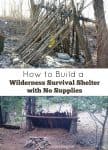


I would be very careful about “bugging out” into the wilderness vs leaving what you have in town. Unless there was nothing at all left to work with – even your pack, tools, and supplies taken/destroyed – humans are far better off staying where all the supplies they accumulated are there.
These emergency shelters in the wilderness are for extreme circumstances – a hunter injured too far to travel, impending storm, etc. with no other alternative. Otherwise, leaving a standing building, or abandoning a car isn’t a best case decision, it’s a bad one if the supplies and skills aren’t in hand.
Lets take the 2-3 weeks situation – in three seasons, it’s doable because of temperatures and climate, it will likely rain, but the major problem will be a supply of potable water and food – not a shelter. Nobody goes hiking or camping in the wilderness without an ample supply of those, and for the most part – we leave them in the kitchen cabinets and water at the sink.
That is the major failure point of the ‘bugout’ fantasy – it’s simply a quick short cut to a quick end.
As for practice – many of us do that in the fall, it’s called Deer Season.
Good sobering advice tirod. Even in the 3 forgiving seasons, bugs and parasites can be as formidable as 2 feet of snow.
You are absolutely right. I don’t see any way it could ever get to that point. Being from a communist country, many times hiding in plain sight works best of all…every thing else is Hollywood fantasy
Good info to know and practice.
The survival books look interesting. Might there be one condensed version with info from all the sources?
J. Jakle
May 25, 2022
Hello Jackie – sorry the books are all individual PDF files although they are sent in a zip file to keep the size down. We also offer an All Access Pass which gives access to all of our products and has a members area with all the download links in one place. You can see more details here – https://www.primalsurvivor.net/all-access-pass-v2/
Thank you .
question would any of these actually keep me alive for more then 2-3 weeks
Check the long term shelters.
Which do you think the best one would be if for say you’re next to a stream?
It more depends on the terrain and what resources you have nearby. But I wouldn’t get too close to a stream: the stream bed can rise quickly during storms. Also, you should never go to the bathroom near a stream (Leave No Trace!). So, if your shelter was right next to the stream, you’d have to walk a bit each time you needed to go.
These are all great. For someone bugging out in Washington. I live in a treeless desert. What will I tie my tarp to? Just curious if you have any thoughts. I’m thinking of getting two trekking poles but that adds weight. So. . . Any suggestions?
There are some cool trekking pole tents out there. They are a LOT lighter than standard tents because they don’t have poles. The downside is that it is a pain to pitch some of these since you need to stake out the tent. Another option for people bugging out solo would be a bivvy tent. A lot of cyclists use these when traveling and are super light and quick to put up – just a bit claustrophobic compared to a normal tent.
how can i make a shelter if i cant find any huge sticks and i don’t have a tarp?
I would suggest going for day trips in the woods (or whatever wild terrain is near where you live) and practicing with what you find. Most YouTube videos, blogs, etc. make it seem really easy to build a survival shelter but, in many situations, it actually takes a LOT of time. Often, spending extra time scouting out a good location (such as near lots of tree debris or looking for a fallen tree to use as the main frame of the shelter) will make the job easier.
In answer to your question, most survival shelters (as opposed to long-term bushcraft shelters) should be very small since the small size will help trap body heat better. You don’t need really big sticks to make these. You could, for example, prop a lot of smaller sticks against a boulder, fallen tree, small mound of dirt, etc. to make an A-frame style shelter. Without a tarp, you will need lots of leaves/debris to pile on top of the frame in order to keep rain and wind out as well as to trap heat. There have been also been plenty of cases of people lost in the wilderness who survived by burying themselves in piles of leaves or even covering themselves with dirt for insulation. Obviously this isn’t ideal or comfortable, but the people survived.
use tiny sticks and tie with vines, maybe. you could use anything if you think about it, ad i thought the same thing about the tarp.
Excellent post for those of us with disabilities.
Can do a ton of stuff with just a tarp, mylar, and some paracord rope. Very light. Make the shelter with the tarp and paracord and put your stuff on the mylar to stay out of the dirt.
what if you had no tarp, or nothing. i think the lean-to shelter is the best, but it is just my apoin.
My best friend and I used to build all sorts of forts in the woods to play in. Our favorite was a “straw house.” We built a frame from sticks, somewhat like the ones you show, but we had four walls and a roof. Then we wove long grass clippings from a nearby field through the sticks. Plenty of room for two girls to play in. We even furnished it with some furniture we rescued from people’s trash. The trees of the woods protected it from the weather pretty well, but the boys did like to trash it almost every night. We rebuilt every day. Who knew we were practicing survival skills!
As silly as it sound my brother and I use to build this types of shelters as kids for fun . Dad supervised and inspected our play fort . I from up thinking everyone’s dad taught their kids these . Later I realised he was teaching us wilderness first aid and survival
Not silly at all, great memories to have, sounds like a smart Dad.
Thank you so much, the assignment got a A as long as i write it correctly
My Rating For this site
5 stars
Awesome man – well done.
I am looking for shelter makiing in the wilderness if I am left with
Nothing
Hi David – that is exactly what this post is about – what are you specifically looking for?
hi primal survivor,
Are you a AI or a real person and i am doing this for a school assignment.
So can you give me a suggestion of what you would think would be the best shelter to
build with no tools or anything?
Hi Seth – last time I looked I was a real person! We have just the post for you – How To Build A Shelter With No Supplies Good luck with the assignment.
Hi, I think that this would be more useful if it really were about making shelters with LITERALLY nothing. Lots of these have tarps involved – where would I find a tarp in the wild? That’s what I think.
Not sure what you mean, there are several debris shelters mentioned?
In that case, the A-frame debris shelter or fallen-tree shelter are probably the best choices. They can be made relatively quickly using just sticks. You pile on lots of sticks, leaves, dirt, etc over the frame to trap heat and keep rain out. I’ve made these with my kids and it takes us less than an hour to make something suitable for survival. But having a tarp definitely makes things a lot easier and protects you from the elements! The bottom line is that people should never go into the wilderness — even for “just a short hike” — without basic emergency supplies!
Maybe read the entire article? That’s what I think. 🙂
I think that he wants to know, like if he didn’t have a tarp or as many supplies
Ive read if you add moss over your shelter it helps keep some warmth and dryness to it. Just a slight tip thar was passed to me.
Take the moss and put in the cracks between the logs. It provides a better insulation and helps to to keep you dry.
me too, I am looking at having a shelter that can protect me from the cold and environment, simple but with a roof and flooring, what do you have to teach me…
If you got there by car or truck, it’s far more comfortably, dry, warmer & safe from wind or falling branches etc. My 1960s half-kg nylon triangular tent with the top end ropes tied to rocks or branches is equally good anytime,